The Process…How the seed of a story became a full-blown book
And how you can re-write a story you tell yourself
Hello, hello, hello! I’m super excited to share this The Process post with you. What’s The Process? I’m glad you asked.
It’s an occasional deep dive into the creative process and personal inner work and a supportive processto help you to explore and enrich your own creativity and inner world.
In this first post, I’m going to share more deeply about my creative process. Next time, I’ll share more about my personal inner work. Both can’t exist without the other. My creative work requires inner excavation and my inner work is highly creative. That’s the beauty of it all - they both serve each other.
As I was preparing to launch my debut YA contemporary romance, Never, Not Ever, I dug out the notebooks where it all began. I was scared that someone would ask me that common author question, ‘Where did you get the idea?’ and my answer would be, ‘Absolutely, no clue.’
Flipping through the notebooks, it was fascinating to me that this story became what it did. I mean, where we started and where we got to was not a thought-through, linear or even sensical process. Let me show you…
The seed of an idea
I’ve shared before that I base my writing process on a hacked version of Lisa Cron’s book, The Story Genius. What’s the first thing you do when you’re beginning a new book? Write chapter 01, scene 01, sentence 01?
Actually, no. We take a step back and consider the story idea. That’s because, according to Lisa, story has a number of expectations and the most important one is that it ‘will make a point about human nature, what makes people tick.’
To discover the point, I begin by brainstorming ‘How did I come up with the idea?’ As you’ll see, I didn’t have a clear idea before I began answering that question. But by the time, I’d finished, the idea had emerged. Here’s word for word what I wrote in my notebook.
‘How did I come up with the idea?’
At first, I was thinking, my planning parts were thinking, about a series of books because that’s a good career move. And the idea was about a young therapist who works in a small practice with her mentor and best friend and they specialise in helping clients with their love life. And she’s in a relationship that she thinks is good - but it isn’t and then it implodes and she realises she needs to go to therapy.
And it’s a good idea but I don’t think it’s what my first book is. Yes, there needs to be therapy. That feels really important.
There’s a bigger mission here about self-revelation and how that opens the heart and opens us up to ourselves and the world.
And self-revelation doesn’t just happen. It can be taught and facilitated.
So yes, therapy. And then I had an idea to set it in a high school with a high school therapist and that could be a series too. But no. No series at this stage.
I realise I need to write my story. Not my literal story. But my emotional one. And it’s going to begin at 16 years old. One summer.
Okay, a solid start. I went from trying to strategise a book series to allowing the emotion to pull me forward. What story did I really want to tell? An emotional one that I felt deep within.
Next, to get out of my thinking brain, I pulled some tarot cards. I’m a fan of using oracle and tarot decks as a way to spark inspiration and intuition. Rather than trying to think through a response to these questions, I asked the cards and noticed what emerged.
What the tarot cards said
I asked the tarot cards, three questions:
What is the change this book wants to see in the world?
The Hermit - How can I pause and come home to the here and now?What is the point? What does this book want to say about human nature?
The Tower - How am I transforming? How can I nurture myself through this process?
What will the protagonist have to face, need to learn?
8 Swords - How can I be open to greater ease and unforeseen solutions in moments where I feel stuck?
Looking back, these cards really did me lead me forward into the story I eventually wrote. These three cards started to paint a picture of a 16-year-old who’s going on an inner quest to reveal something about herself (The Hermit) after something true and important to her has crumbled, creating a seismic shift in her world (The Tower) forcing her to face self-doubt, insecurities and fears (8 Swords).
This is the top line meanings of these cards. If you want to go deeper, and I always do throughout the creative process, then I can recommend Tarot for the Wild Soul. The prompts above were taken from Lindsay’s free Ultimate Soul Tarot Card Guide, available on her website.
Okay, so I’ve now got the sense of a story. But it’s still pretty vague, isn’t it? This could actually be a million different stories so how did I come to write the one I did?
The next step was to consider the story’s, What if? The main character has an internal struggle - her self-doubt, insecruities and fears. We don’t yet know the specifics but we know she’s got them. Then something external happens to trigger that internal struggle, to set her off on a path where she has to face her problems. Here’s what I came up with.
What if?
What if a 16 year old’s world is turned upside down when her grandmother and main emotional support suddenly dies (leaving her alone with the workaholic and emotionally unavailable mother) and the father she never knew turns up expectedly wanting a relationship, wanting to know her, forcing her into therapy and her inner world so she faces her inner doubts, insecurities and fears, overcomes the deep misbelief that she is unwanted and unlovable and begins to like herself a little more and opens her heart up to the boy who loves her, who lives right next door.
Phew! That’s a lot. But interestingly, this is the crux of the story I ended up writing. Once this ‘what if’ brainstormed its way out of my brain or was downloaded from the ether, the idea stuck and it fuelled the story forward.
But even though it’s more specific, we still don’t know very much about our protagonist, do we? Who is she, really? What does she want? What is going to get in the way of what she wants?
So next, we create the protagonist’s thumbnail.
Who is the main character?
Nb. I’ve redacted a bit in the image above to save spoilers! And FYI, at this stage she was named, Chloe. But she later told me that her name was Tilly.
Here are the questions we’re trying to answer: Before the novel begins, who are they on the inside? What do they believe? What do they want? Where are they in their life?
Here’s my brainstorm:
Chloe (aka Tilly) is on the cusp of her 16th birthday. She lives with her mum who is a workaholic and is emotional unavailable, a family lawyer in her own small practice. She works long hours and Chloe is left alone a lot. That used to be sort of okay when her grandmother was alive and during school term because she loves school, not so much the other kids and social issues, but she loves study.
But it’s the summer holidays and her grandma died 3 months ago and her mum has been working more than ever, busying herself and hiding from her grief. But with so many long summer days there is nowhere for Chloe to hide from her grief.
She watches as much Netflix and reads as many books as she can but it’s not enough. Her best friend is away with her family on summer holidays and lots of the other kids from school, based on their social media, look like they’re having a lot more fun than her.
The only salvation is Zack, next door.
Again, this is essentially the set up. It didn’t really change. But it also doesn’t tell us about what she wants, specifically, and why she wants it. I needed to dig some more.
What does she want?
She wants Josh from school to ask her out and for them to hang out all day and talk and have fun and have this instant connection where he tells her how amazing she is and how much he likes her and how long he’s wanted to ask her out but he wasn’t sure if she was interested. And she wants him to fill her summer days so she feels wanted and loveable.
She also wants her dad to knock on their front door on her 16th birthday with flowers and a beautiful necklace boxed up so beautifully and to welcome her into his life and say he’s been gone so long and he is so sorry and that he has missed her first 16 years but he is back now and he loves her and he wants her in this life and he wants to make it up to her.
And why does she want it? What will getting it mean to her? What will it say about her?
Getting what she wants will mean that she’s not alone, she’s not lonely, she’s wanted, she’s loved, she’s capable of being loved and that people want to be with her and want to stay.
Okay, now we’re getting more of a picture. Yes, she’s forced into an inner quest (The Hermit) after her grandmother passes away (The Tower) but it’s her doubts and fears about being unloveable and about being abandoned that are going to drive the story (8 Swords).
Good stuff. But not yet enough to begin writing. We still need to know what happened in her past that seeded this misbelief, this idea that she was unlovable and that people would abandon her.
Defining moment in her life
Chloe (aka Tilly) is 5 years old, in reception class at school. The teacher has asked them all to draw a picture and then tell the class a bit about their mum and dad. Chloe has drawn her mum with a briefcase and her dad as an astronaut. She gets up at the front of class and says that her mum is always at work and her dad is off in space.
The other kids laugh and then Megan puts up her hand and says, ‘Chloe is lying. She doesn’t have a dad.’ The teacher says, ‘Yes, well, I’m not sure if he is an astronaut, dear’ and tells her to sit down.
Chloe feels deep shame as she sits back down and her hears Briony ask Megan, ‘Why doesn’t she have a dad?’ Megan says, ‘Because he doesn’t love her. That’s what my mum said.’
Oh, poor 5-year-old Tilly! This ends up being the germination of her sense that not everyone in her family is telling the truth, there are secrets and, perhaps, lies.
Now, we just needed one more element. What was going to set her off on this adventure? What was the unavoidable external change that catapults her into the fray and triggers her internal battle?
The ticking clock
Lisa Cron suggests tracking the ticking clock, the series of events that get your protagonist to the start of the story. Here’s what I journaled:
Grandma dies
Summer begins
Mum ignores her birthday
She goes roaming with Zack, has fun, he’s so caring but it’s unsettling
She arrives back home and her dad is in the living room
None of these are spoilers. But they are literally how the story begins.
These are the series of steps that brought me to writing chapter 01, scene 01, sentence 01. And you know what, even though the first chapter did change, the first paragraph didn’t.
This is what I wrote in the first draft:
January 01. My 16th birthday. I should be smiling, cheering and doing cartwheels, probably. But no one wants their birthday on the first day of January. Especially not me. And especially not this year.
And this is what was published in the final version:
One January. My sixteenth birthday. I should have been smiling, cheering and doing cartwheels. But no one wants to have their birthday on the first day of January. Especially not me. And especially not this year.
That was the seed of the book that became this:
Here’s the back cover blurb - see how the story integrated?
Every year, Tilly dreams of the dad she’s never known showing up for her birthday. But he never does. When she wakes up on the morning of her sixteenth birthday dadless yet again, she knows it’ll never happen.
In fact, it’s her worst birthday ever because her grandmother died a few months ago, her mum is working again, and the boy she’s in love with—the ridiculously gorgeous Josh—refuses to break up with his drama-queen girlfriend and notice her instead.
Then Tilly’s dad does show up, shocking everyone, and she works out an awful truth: Her mum and her grandma lied to her. For sixteen years! Tilly is drowning in her family’s lies. Worse, these feelings for her neighbour Zack—these stupid, flustering, more-than-friends feelings she’s been trying to ignore—mean she’s also lying to herself.
Ta da! That’s it. A portion of the creative process. To go from some general idea about a book that included therapy (there is therapy in the book) to a specific story about 16 year old grieving her grandma, and meeting the dad she’s never known and falling in love with the boy next door (that’s Zack, not Josh - he was a diversion :)
Does it feel like my emotional story? Well, yes, and no. In no way does this book resemble my life. But it does contain that teen hyper sense of feeling misunderstood, unvalidated and surprised by life. I felt all of those things.
And interestingly, even though my thinking parts were angling for a series from the beginning and were trying to game the process to make it happen, Never, Not Ever is the first in a series of books. Each book can be read as a standalone story but they each follow a different main character from the same friendship group.
Over to you
We all have main character energy in our own lives so here is a process that you can try for yourself.
It’s a way to explore our inner and outer worlds to highlight the interchange, mismatch and intuitive gold.
We’re all capable of re-writing a story we tell ourselves because, truly, you are the most incredible story of all.
Comments or questions?
I’m always happy to answer any questions you may have. Hit reply to this email or post in the comments.
Plus feel free to share your thoughts about this ritual. Interesting? Helpful? Is there a story you’re telling yourself that you’d like to rewrite? What’s the story you want to believe now?
You can see my response in the comments below.
And an invitation for you before I go…
If you’re interested in checking out more about Never, Not Ever, including reading the first two chapters, you can follow this link.
Until next time,
Love to you and yours!


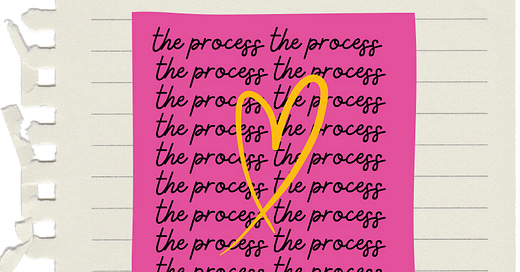



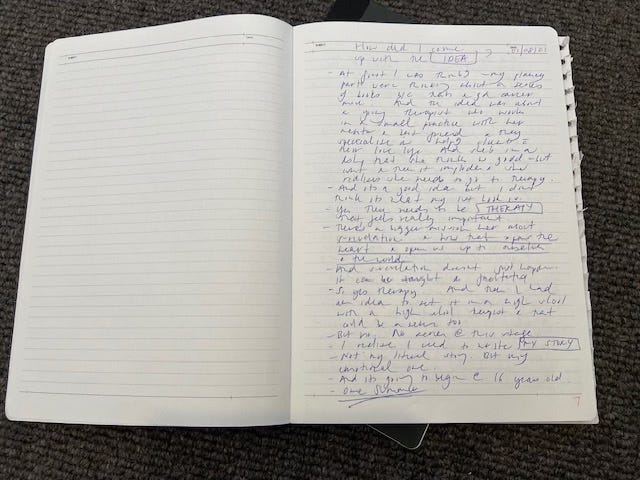
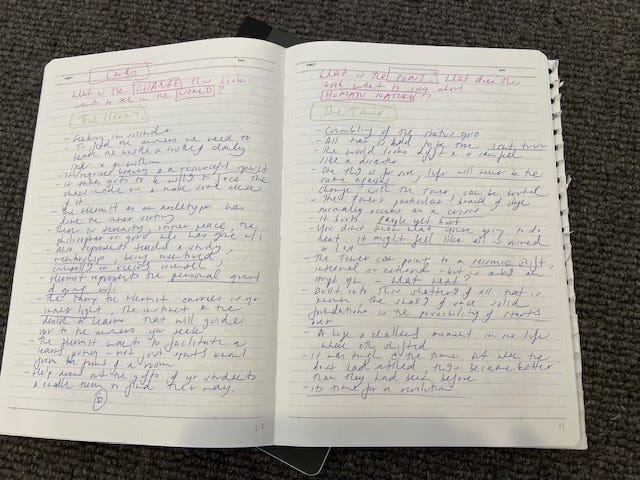
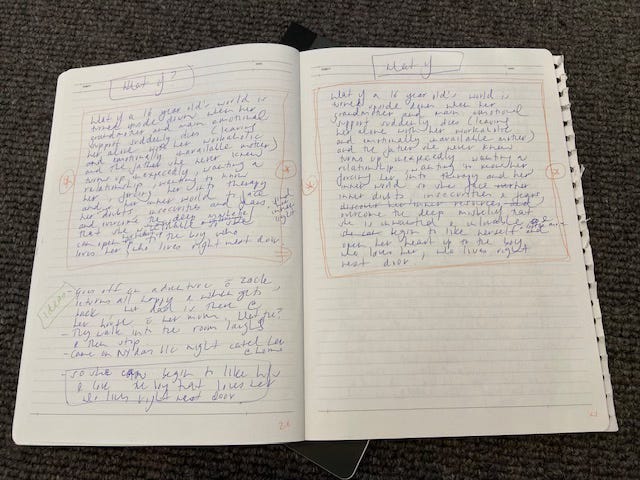
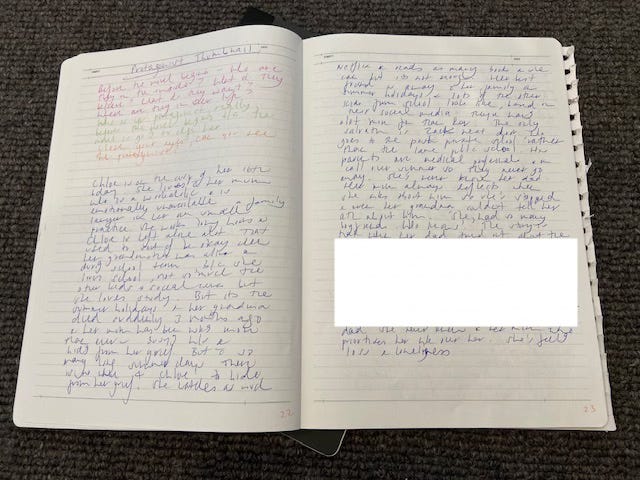

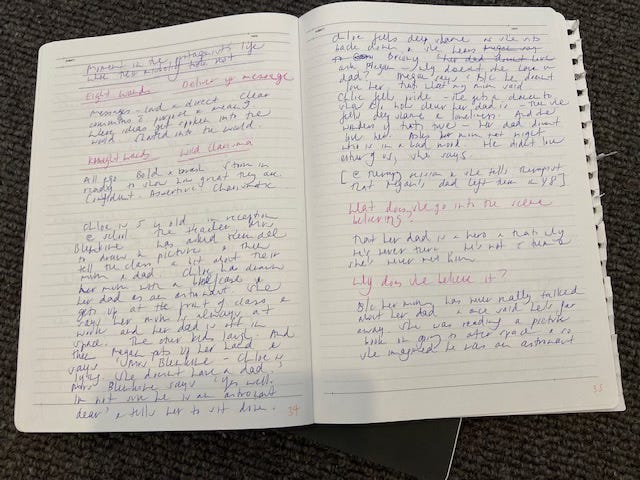

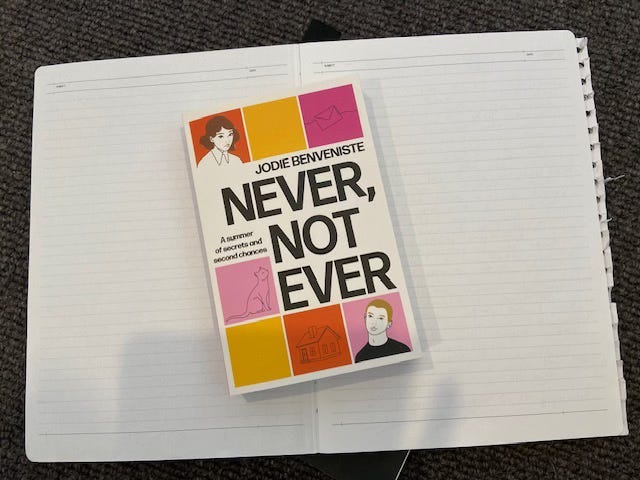
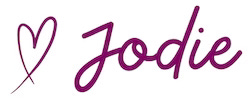
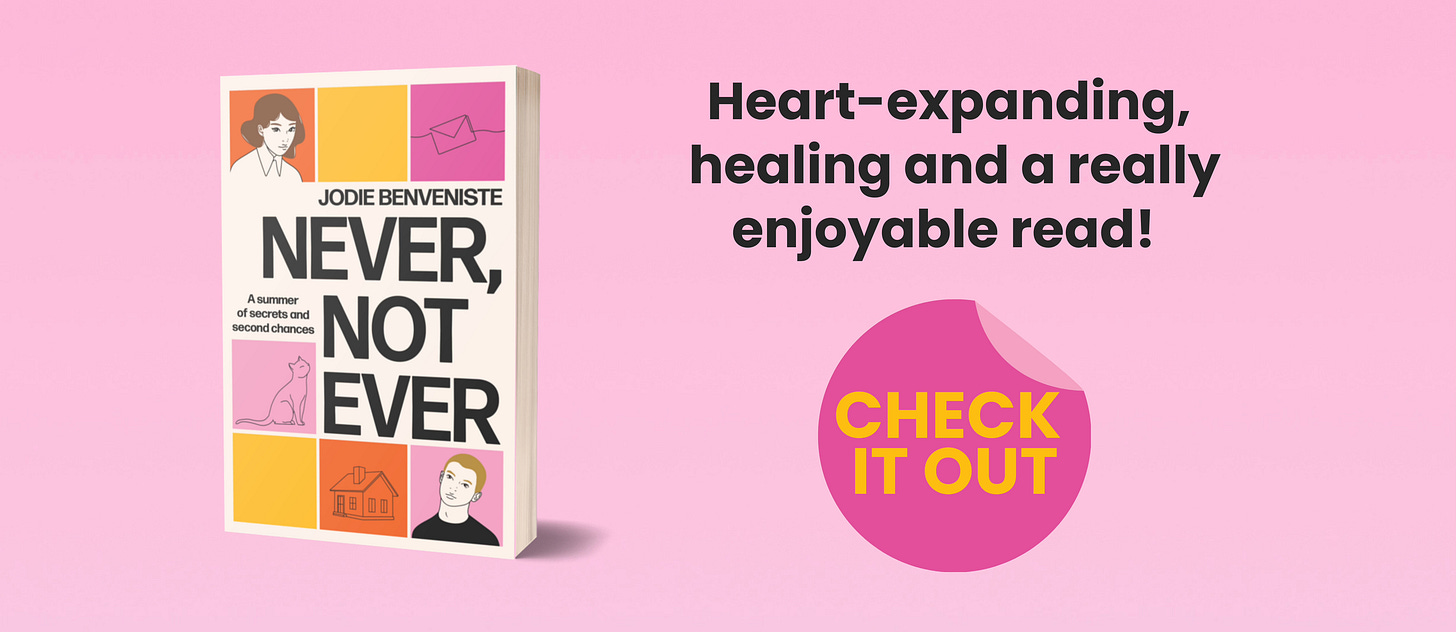
What aspect of your life are you struggling with right now or would you like to see a shift in? Shining more brightly, being more seen and known.
Are there any people or situations that are highlighting that struggle? I have parts who are saying, it’s so much work to promote your book! There are too many options and too many people to contact and it’s all too much!
What is the desire deep within you that this external struggle is highlighting? We do really want to help people and have an impact.
What is the misbelief that’s getting in the way of you pursuing your deep desire? That we need to do a lot of things to make this happen. Otherwise, how will people find me and my work?
Is there a moment or moments in your life where the misbelief was seeded? Hard work was the way modelled to me growing up. The message from society was, You don’t get anywhere if you don’t work hard. That led to four bouts of burnout. We can’t do that again.
What new belief do you want to embrace? We want to show up in ways that feel good and allow synchronicity and a bit of magic to help too! My parts are loving that idea so we’re going to welcome in that belief and see what happens!